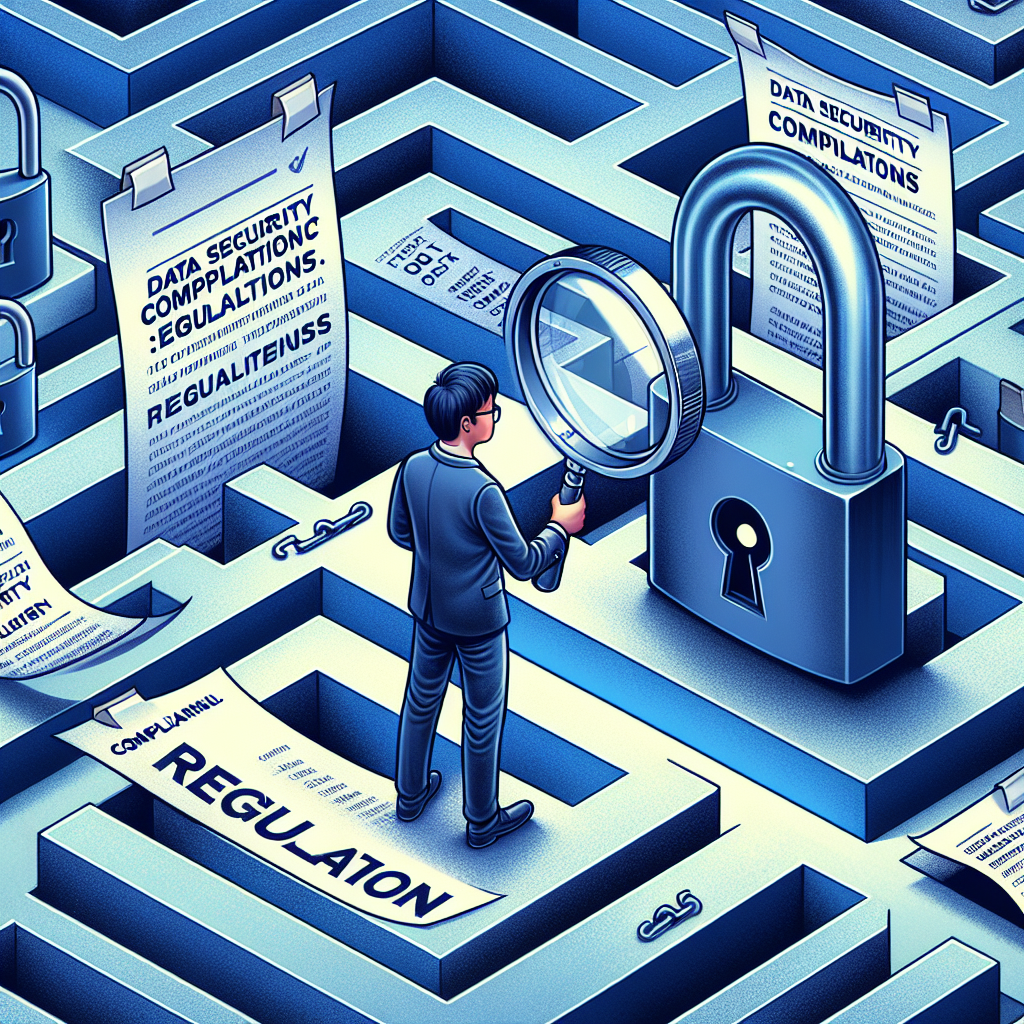Exploring the Depths of Data Security Compliance Regulations: What You Need to Know
September 12, 2024 | by Jefferey Rocha

In today’s digitally-driven world, safeguarding sensitive information has become a top priority for organizations. Data security compliance regulations serve as essential guidelines to protect valuable data against cyber threats and breaches. These regulations outline the necessary measures that businesses need to take to ensure the confidentiality, integrity, and availability of their data. From GDPR to HIPAA, navigating the complex landscape of data security compliance can be overwhelming. This article delves deep into the realm of data security compliance regulations, providing you with the key information you need to stay ahead of the game and protect your organization’s most valuable asset – its data.
Understanding Data Security Compliance Regulations

Definition of Data Security Compliance Regulations
Understanding Data Security Compliance Regulations
Data security compliance regulations refer to the set of rules and standards that organizations must follow to safeguard sensitive information and maintain the privacy of individuals. These regulations are designed to ensure that data is collected, processed, and stored securely to prevent unauthorized access, use, or disclosure. Compliance with these regulations is crucial for organizations to protect data from breaches, cyber attacks, and other security threats.
Importance of adhering to regulations:
– Ensures the confidentiality and integrity of data
– Builds trust with customers and stakeholders
– Helps in avoiding costly fines and legal consequences
– Demonstrates commitment to data protection and privacy
Overview of different regulatory bodies:
1. GDPR (General Data Protection Regulation):
– Regulates the processing of personal data of individuals in the European Union (EU)
– Focuses on data protection and privacy for EU citizens
– Imposes strict requirements on organizations handling personal data
- HIPAA (Health Insurance Portability and Accountability Act):
- Governs the protection of sensitive patient health information
- Applies to healthcare providers, health plans, and healthcare clearinghouses
-
Requires safeguards to ensure the security and privacy of health data
-
PCI DSS (Payment Card Industry Data Security Standard):
- Establishes security standards for processing payment card transactions
- Applies to organizations that accept, store, or transmit credit card information
- Aims to prevent credit card fraud and enhance payment card data security
Adhering to these data security compliance regulations is essential for organizations to mitigate risks, protect sensitive information, and uphold the trust of their customers and stakeholders.
Key Components of Data Security Compliance Regulations
Data security compliance regulations encompass a range of key components that organizations must adhere to in order to protect sensitive information and mitigate cybersecurity risks. Understanding these components is crucial for ensuring legal and ethical data handling practices. The main key components of data security compliance regulations include:
-
Data Encryption Requirements: Data encryption is a fundamental aspect of protecting sensitive information from unauthorized access. Compliance regulations often mandate the encryption of data both in transit and at rest to safeguard it from potential breaches. Implementing robust encryption protocols helps organizations maintain the confidentiality and integrity of their data, reducing the risk of exposure to cyber threats.
-
Access Control Measures: Controlling access to data is essential for maintaining data security and compliance. Compliance regulations typically outline strict access control requirements to ensure that only authorized individuals can view or manipulate sensitive information. Implementing strong authentication mechanisms, role-based access controls, and regular access reviews are common practices to enforce access control measures effectively.
-
Incident Response and Reporting Procedures: In the event of a data breach or security incident, organizations must have robust incident response and reporting procedures in place to mitigate the impact and comply with regulatory requirements. Compliance regulations often specify the necessary steps organizations must take to contain and investigate security incidents, notify affected parties, and report the breach to relevant authorities within specified timeframes. Establishing a well-defined incident response plan is critical for minimizing the consequences of data breaches and demonstrating compliance with data security regulations.
Importance of Data Security Compliance
Protecting Sensitive Information
In the realm of data security compliance, protecting sensitive information is paramount to maintaining the trust and integrity of an organization. This involves implementing robust measures to safeguard various types of data, including personal details, financial records, and proprietary business information. By adhering to data security compliance regulations, companies can mitigate the risks associated with unauthorized access, misuse, or theft of sensitive data.
-
Safeguarding customer data: Organizations must prioritize the protection of customer data to uphold privacy standards and comply with regulations such as the General Data Protection Regulation (GDPR) and the Health Insurance Portability and Accountability Act (HIPAA). This entails encrypting sensitive information, implementing access controls, and regularly monitoring and auditing data systems to detect any potential vulnerabilities or breaches.
-
Preventing data breaches and cyber attacks: Compliance with data security regulations is essential for preventing data breaches and cyber attacks that can have severe consequences for both businesses and individuals. By establishing robust cybersecurity measures, such as firewalls, intrusion detection systems, and regular security assessments, organizations can fortify their defenses against malicious actors seeking to exploit weaknesses in data systems. Additionally, conducting employee training programs on data security best practices can help raise awareness and reduce the risk of human error leading to data breaches.
Building Trust and Reputation
In the realm of data security compliance, building trust and reputation is paramount for organizations seeking to establish credibility and reliability in the eyes of their customers and stakeholders. This trust is not just a matter of perception; it is intricately tied to the ability of a company to safeguard sensitive information and uphold the principles of data protection. Let’s delve into how data security compliance contributes to enhancing trust and reputation:
-
Enhancing Customer Confidence: By adhering to data security compliance regulations, organizations demonstrate their commitment to protecting customer data and maintaining confidentiality. Customers are more likely to trust companies that prioritize data security, knowing that their personal information is being handled responsibly and securely. This trust forms the foundation of strong, long-lasting relationships between businesses and their clientele.
-
Avoiding Legal Repercussions and Financial Losses: Non-compliance with data security regulations can result in severe legal consequences and substantial financial losses for organizations. By proactively complying with relevant laws and regulations, companies mitigate the risk of facing lawsuits, fines, and reputational damage due to data breaches or mishandling of sensitive data. Compliance not only protects the organization but also instills confidence in customers that their data is being handled in accordance with established standards and guidelines.
In essence, prioritizing data security compliance not only safeguards sensitive information but also fosters a culture of trust and reliability that is indispensable in today’s data-driven business landscape.

Challenges in Achieving Data Security Compliance
Complexity of Regulations
- Navigating through multiple regulatory requirements
Achieving data security compliance can be a daunting task due to the multitude of regulatory requirements that organizations need to adhere to. Depending on the industry, location, and type of data being handled, companies may be subject to various regulations such as GDPR, HIPAA, PCI DSS, or SOX. Each of these regulations has its own set of stipulations and guidelines that must be followed meticulously to ensure data security compliance.
- Ensuring compliance with evolving laws and standards
Another challenge in the realm of data security compliance is the ever-evolving nature of laws and standards. As technology advances and new threats emerge, regulatory bodies continuously update and revise their mandates to reflect the changing landscape of data security. This dynamic environment requires organizations to stay abreast of the latest developments in order to remain compliant and safeguard their data effectively. Failure to keep up with these changes can result in non-compliance and potentially severe consequences for the organization.
Resource Constraints
- Allocating Sufficient Budget and Manpower
In the realm of data security compliance, one of the paramount challenges that organizations face is the allocation of adequate financial resources and skilled manpower to effectively implement and maintain compliance measures. Without a dedicated budget specifically earmarked for data security initiatives, organizations may find themselves struggling to procure the necessary tools, technologies, and expertise required to safeguard sensitive information effectively. Furthermore, the shortage of skilled professionals in the field of cybersecurity adds another layer of complexity to the resource allocation dilemma. Hiring and retaining qualified personnel with the requisite knowledge and experience in data security compliance can be a daunting task, especially for organizations operating in highly competitive industries where demand for such talent far exceeds the available supply.
- Implementing Necessary Technological Solutions
Another critical aspect of resource constraints in data security compliance revolves around the implementation of appropriate technological solutions. Ensuring the confidentiality, integrity, and availability of data necessitates the deployment of robust security infrastructure, including firewalls, encryption tools, intrusion detection systems, and access control mechanisms. However, acquiring and deploying these technologies often entails substantial upfront costs, ongoing maintenance expenses, and the need for continuous upgrades to keep pace with evolving cyber threats. Additionally, the complexity of integrating disparate security solutions into a cohesive framework that aligns with regulatory requirements further compounds the resource constraints faced by organizations striving to achieve and maintain data security compliance.
Strategies for Ensuring Data Security Compliance
Conducting Regular Risk Assessments
In the realm of data security compliance, conducting regular risk assessments is a fundamental practice to identify potential vulnerabilities and ensure proactive security measures are in place. This proactive approach enables organizations to stay ahead of emerging threats and maintain compliance with regulations. Here are key details to consider when conducting regular risk assessments:
- Identifying potential vulnerabilities:
- Organizations need to meticulously assess their systems, networks, and processes to pinpoint any weaknesses that could be exploited by malicious actors.
- This involves analyzing data storage practices, access controls, encryption methods, and potential points of entry for cyber threats.
-
By identifying vulnerabilities early on, organizations can take swift action to address these weak spots and fortify their overall data security posture.
-
Implementing proactive security measures:
- Once vulnerabilities are identified, it is crucial to implement proactive security measures to mitigate risks and enhance data protection.
- This may involve deploying advanced cybersecurity tools, conducting employee training on security best practices, and regularly updating security protocols.
- Proactive security measures can include real-time monitoring of network activities, regular security audits, and incident response plans to swiftly address any security breaches that may occur.
By consistently conducting thorough risk assessments, organizations can proactively safeguard their data assets, maintain compliance with regulations, and uphold the trust of their customers and stakeholders in an increasingly digital landscape.
Employee Training and Awareness
To uphold data security compliance within an organization, educating staff on data protection best practices is paramount. This involves providing comprehensive training sessions that cover various aspects of data security, including the importance of safeguarding sensitive information, recognizing potential security threats, and understanding compliance regulations relevant to their roles. By equipping employees with the knowledge and skills necessary to identify and mitigate security risks, organizations can establish a culture of vigilance and accountability when it comes to data protection.

Furthermore, ensuring compliance at all levels of the organization is essential for maintaining robust data security practices. This requires not only providing initial training to employees but also implementing ongoing awareness programs to reinforce compliance measures. Regular communication about data security policies, updates on regulatory requirements, and reminders about best practices can help cultivate a strong culture of compliance throughout the organization. Additionally, conducting periodic assessments and audits to monitor adherence to data security protocols can identify any gaps or areas that require further training or reinforcement.
Best Practices for Data Security Compliance
Implementing Data Encryption
Data encryption is a fundamental component of comprehensive data security compliance measures. By encrypting data, organizations can ensure that sensitive information is protected both when it is in transit and at rest. This process involves encoding data in such a way that it can only be accessed or decrypted by authorized parties with the necessary encryption keys.
Securing data in transit and at rest:
– When data is in transit, such as being transmitted between servers or devices, encryption protocols like SSL/TLS can be employed to create secure connections and prevent unauthorized access or interception of data.
– For data at rest, stored in databases, servers, or other repositories, encryption mechanisms such as AES encryption can be utilized to safeguard information from being compromised in case of unauthorized access.
Utilizing encryption protocols to protect sensitive information:
– Organizations should implement robust encryption protocols that align with industry standards and best practices to protect sensitive data effectively. This includes encrypting not only personal information but also financial data, intellectual property, and other confidential data sets.
– Regularly updating encryption keys and algorithms is essential to stay ahead of potential security threats and ensure data remains secure even as cyber threats evolve.
In conclusion, implementing data encryption is a critical aspect of data security compliance, providing a layer of protection that is essential for safeguarding sensitive information from unauthorized access and potential breaches.
Regular Audits and Compliance Checks
Best Practices for Data Security Compliance
- Monitoring and evaluating security measures
Regular audits and compliance checks are essential components of maintaining data security compliance. These processes involve constantly monitoring and evaluating the security measures put in place to safeguard sensitive information. By regularly reviewing the effectiveness of security protocols, organizations can identify any potential vulnerabilities or weaknesses in their systems.
- Addressing any non-compliance issues promptly
In the event that non-compliance issues are identified during audits or checks, it is crucial to address them promptly. Failure to rectify non-compliance issues in a timely manner can leave systems and data exposed to potential security breaches. By promptly addressing any issues that arise, organizations can ensure that they remain in line with data security compliance regulations and mitigate the risk of data breaches.
FAQs for Exploring the Depths of Data Security Compliance Regulations: What You Need to Know
What are data security compliance regulations?
Data security compliance regulations are laws and guidelines that organizations must follow to ensure the protection of sensitive data. These regulations dictate how data should be stored, accessed, and transmitted to prevent unauthorized access, data breaches, and other security risks.
Why are data security compliance regulations important?
Data security compliance regulations are important because they help protect sensitive information from being compromised. Implementing these regulations within an organization ensures that appropriate security measures are in place to safeguard data and prevent costly data breaches. Failure to comply with these regulations can result in legal consequences and damage to an organization’s reputation.
What are some common data security compliance regulations?
Some common data security compliance regulations include the General Data Protection Regulation (GDPR) in the European Union, the Health Insurance Portability and Accountability Act (HIPAA) in the United States, and the Payment Card Industry Data Security Standard (PCI DSS) for organizations that handle credit card information. These regulations outline specific requirements that organizations must adhere to in order to protect sensitive data.
How can organizations ensure compliance with data security regulations?
Organizations can ensure compliance with data security regulations by conducting regular security assessments, implementing strong data encryption protocols, restricting access to sensitive data, training employees on security best practices, and staying up to date with the latest regulations and industry standards. It is also important for organizations to have a designated data protection officer or compliance team responsible for overseeing and enforcing compliance efforts.
What are the consequences of non-compliance with data security regulations?
The consequences of non-compliance with data security regulations can be severe and may include fines, legal actions, data breaches, reputational damage, and loss of customer trust. In some cases, non-compliance can result in significant financial losses and even the closure of the organization. It is crucial for organizations to take data security compliance seriously and implement robust security measures to protect sensitive information.
RELATED POSTS
View all

